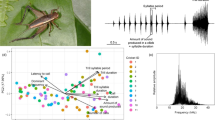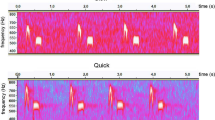Abstract
Intraspecific variation in a resting metabolic rate (RMR) is likely to be an important determinant of energetic-resource use and may influence the resources subsequently available for allocation to traits not directly associated with somatic maintenance. The influence of RMR on resource availability could be especially important for condition-dependent sexual traits, such as cricket calls, that are themselves energetically costly to produce. RMR may also be associated with longevity, either negatively because individuals with a high RMR burn resources faster and die young, or positively as individuals with high RMR are more able to accrue resources to fuel survival. Additionally, the associations between RMR and other characters may vary across populations if differential selection or drift shapes these traits. Here we tested for differences in RMR, body mass, calling effort, and longevity in two populations of cricket Gryllodes sigillatus and then evaluated the potential influence of RMR on calling and longevity. We find that RMR, calling effort, and longevity varied across populations, but mass did not. Controlling for population and mass, RMR was not significantly associated with calling effort, but was negatively associated with longevity. These findings suggest that male crickets that live fast die young.

Similar content being viewed by others
References
Alexander RM (1999) Energy for animal life. Oxford University Press, Oxford
Arnqvist G, Dowling DK, Eady P, Gay L, Tregenza T, Tuda M, Hosken DJ (2010) The genetic architecture of metabolic rate: environment specific epistasis between mitochondrial and nuclear genes in an insect. Evolution 64:3354–3363
Bailey WJ, Withers PC, Endersby M, Gaull K (1993) The energetic cost of calling in the bushcricket Requena verticalis (Orthoptera: Tettigoniidae: Listrocelidinae). J Exp Biol 178:21–37
Bennet AF, Ruben JA (1979) Endothermy and activity in vertebrates. Science 206:649–654
Bentsen CL, Hunt J, Jennions MD, Brooks R (2006) Complex multivariate sexual selection on male acoustic signaling in a wild population of Teleogryllus commodus. Am Nat 167:E102–E116
Bertram SM, Johnson L (1998) An electronic technique for monitoring the temporal aspects of acoustic signals of captive organisms. Bioacoustics 9:107–118
Biro PA, Stamps JA (2010) Do consistent individual differences in metabolic rate promote consistent individual differences in behavior? Trends Ecol Evol 2:653–659
Brown EA, Gay L, Vasudev R, Tregenza T, Eady PE, Hosken DJ (2009) Negative phenotypic and genetic associations between copulation duration and longevity in male seed beetles. Heredity 103:340–345
Chown SL, Nicolson SW (2004) Insect physiological ecology. Mechanisms and patterns. Oxford University Press, Oxford
Cotton S, Fowler K, Pomiankowski A (2004) Do sexual ornaments demonstrate heightened condition-dependent expression as predicted by the handicap hypothesis? Proc R Soc Lond B 271:771–783
Daan S, Masman D, Groenewold A (1990) Avian basal metabolic rates: their association with body composition and energy expenditure in nature. Am J Physiol 259:R333–R340
de Jong G, van Noordwijk AJ (1992) Acquisition and allocation of resources: genetic (co)variances, selection, and life histories. Am Nat 139:749–770
Dowling DK, Simmons LW (2009) Reactive oxygen species as universal constraints in life-history evolution. Proc R Soc Lond B 276:1737–1745
Getty T (1998) Reliable signalling need not be a handicap. Anim Behav 56:253–255
Grafen A, Hails R (2002) Modern statistics for the life sciences. Oxford University Press, Oxford
Hammond KA, Chappell MA, Cardullo RA, Lin R-S, Johnsen TS (2000) The mechanistic basis of aerobic performance variation in red junglefowl. J Exp Biol 203:2053–2064
Hawkins AJS, Day AJ (1999) Metabolic interrelations underlying the physiological and evolutionary advantages of genetic diversity. Am Zool 39:401–411
Hoffmann AA (1999) Is the heritability for courtship and mating speed in Drosophila (fruit fly) low? Heredity 82:158–162
Hosken DJ, Withers PC (1997) Temperature regulation and metabolism of an Australian bat, Chalinolobus gouldii (Chiroptera: Vespertilionidae) when euthermic and torpid. J Comp Physiol B 167:71–80
Hosken DJ, Withers PC (1999) Metabolic physiology of euthermic and torpid lesser long-eared bats, Nyctophilus geoffroyi (Chiroptera: Vespertilionidae). J Mammal 80:42–52
Hume ID, Biebach H (1996) Digestive tract function in the long-distance migratory garden warbler, Sylvia borin. J Comp Physiol B 166:388–395
Hunt J, Bussiere LF, Jennions MD, Brooks R (2004a) What is genetic quality? Trends Ecol Evol 19:329–333
Hunt J, Brooks R, Jennions MD, Smith MJ, Bentsen CL, Bussiere LF (2004b) High-quality male field crickets invest heavily in sexual display but die young. Nature 432:1024–1027
Hunt J, Jennions MD, Brooks R (2005) Female mate choice as a condition-dependent life-history trait. Am Nat 166:79–92
Hunt J, Jennions MD, Spyrou N, Brooks R (2006) Artificial selection on male longevity influences age-dependent reproductive effort in the black field cricket Teleogryllus commodus. Am Nat 168:E72–E86
Johnston SL, Souter DM, Erwin SS, Tolkamp BJ, Yearsley JM, Gordon IJ, Illius AW, Kyriazakis I, Speakman JR (2007) Associations between basal metabolic rate and reproductive performance in C57BL/6J mice. J Exp Biol 210:65–74
Ketola T, Kotiaho JS (2009) Inbreeding, energy use and condition. J Evol Biol 22:770–781
Ketola T, Kotiaho JS (2010) Inbreeding, energy use and sexual signaling. Evol Ecol 24:761–772
Kotiaho JS (2001) Cost of sexual traits: a mismatch between theoretical considerations and empirical evidence. Biol Rev 76:365–376
Kotiaho JS, Alatalo RV, Mappes J, Nielsen MG, Parri S, Rivero A (1998) Energetic costs of size and sexual signaling in a wolf spider. Proc R Soc Lond B 265:2203–2209
Laivaux SP, Irschick DJ (2006) Functional perspectives on sexual selection: insights and future prospects. Anim Behav 72:263–273
Lindstrom A, Klaassen M, Kvist A (1999) Variation in energy intake and basal metabolic rate of a bird migrating in a wind tunnel. Funct Ecol 13:352–359
McNab BK (2005) Food habits and the evolution of energetics in birds of paradise (Paradisaeidae). J Comp Physiol B 175:117–132
Nespolo RF, Lardies MA, Bozinovic F (2003) Intrapopulation variation in the standard metabolic rate of insects: repeatability, thermal dependence and sensitivity (Q10) of oxygen consumption in a cricket. J Exp Biol 206:4309–4315
Nilsson J-A (2002) Metabolic consequences of hard work. Proc R Soc Lond B 269:1735–1739
Radwan J, Chadzinska M, Cichon M, Mills SC, Matula B, Sadowska ET (2006) Metabolic costs of sexual advertisement in the bank vole (Clethrionomys glareolus). Evol Ecol Res 8:859–869
Reinhold K, Greenfield MD, Jang Y, Broce A (1998) Energetic cost of sexual attractiveness: ultrasonic advertisement in wax moths. Anim Behav 55:905–913
Rezende EL, Bozinovic F, Garland T Jr (2004) Climatic adaptation and the evolution of basal and maximum rates of metabolism in rodents. Evolution 58:1361–1374
Roff DA (2002) Life history evolution. Sinauer, Sunderland
Rowe L, Houle D (1996) The lek paradox and the capture of genetic variance by condition dependent traits. Proc R Soc Lond B 263:1415–1421
SAS Institute (2005) JMP 6.0. SAS Institute Inc., Cary
Sgro CM, Partridge L (2000) Evolutionary responses of the life history of wild-caught Drosophila melanogaster to two standard methods of laboratory culture. Am Nat 156:341–353
Sinclair BJ, Bretman A, Tregenza T, Tomkins JL, Hosken DJ (2011) Metabolic rate does not increase with starvation in Gryllus bimaculatus when changing fuel use is taken into account. Physiol Entomol 36:84–89
Snodgrass JJ, Leonard WR, Tarskaia LA, AlekseevVP KVG (2005) Basal metabolic rate in the Yakut (Sakha) of Siberia. Am J Hum Biol 17:155–172
Speakman JR (2005) Body size, energy metabolism and lifespan. J Exp Biol 208:1717–1730
Terblanche JS, Chown SL (2007) The effects of temperature, body mass and feeding on metabolic rate in the tsetse fly Glossina morsitans centralis. Physiol Entomol 32:175–180
Tomkins JL, Radwan J, Kotiaho JS, Tregenza T (2004) Genic capture and resolving the lek paradox. Trends Ecol Evol 19:323–328
Van Voorhies WA (2001) Metabolism and lifespan. Exp Gerontol 36:55–64
Acknowledgments
JH was funded by NERC and a Royal Society Fellowship, and DJH by NERC. We thank Scott Sakaluk for USA population of G. sigillatus and Leigh Simmons, Tarmo Ketola, and an anonymous referee for the comments which greatly improved the manuscript.
Author information
Authors and Affiliations
Corresponding author
Additional information
Communicated by L. Simmons
Rights and permissions
About this article
Cite this article
Okada, K., Pitchers, W.R., Sharma, M.D. et al. Longevity, calling effort, and metabolic rate in two populations of cricket. Behav Ecol Sociobiol 65, 1773–1778 (2011). https://doi.org/10.1007/s00265-011-1185-3
Received:
Revised:
Accepted:
Published:
Issue Date:
DOI: https://doi.org/10.1007/s00265-011-1185-3




